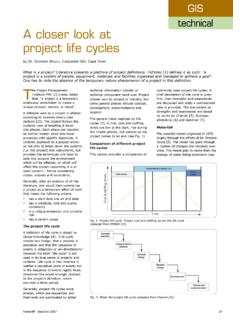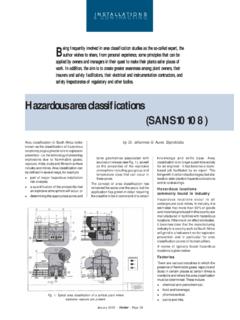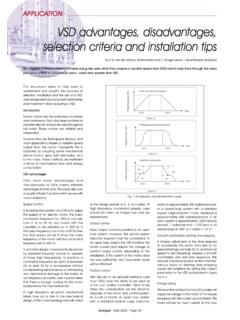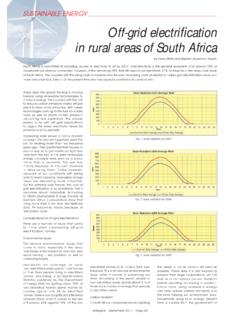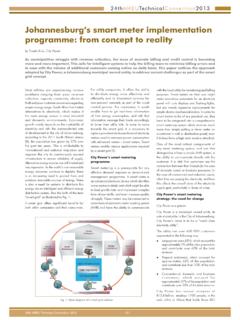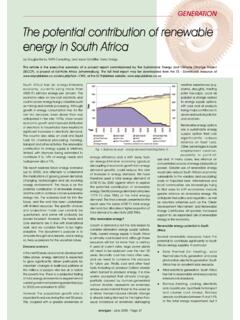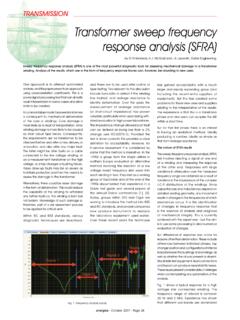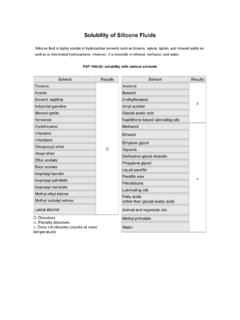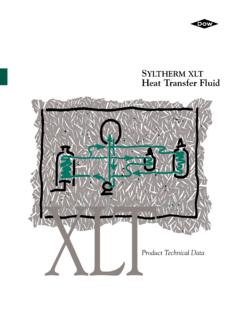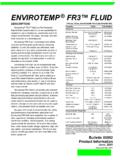Transcription of TR Vegetable oil as insulating fluid for transformers
1 TRANSMISSION AND DISTRIBUTION. Vegetable oil as insulating fluid for transformers by Mike Rycroft, features editor, EE Publishers Oil constitutes a major component of power transformers . Conventionally, mineral or synthetic oils have been used. In an attempt to overcome some of the drawbacks with mineral oils, Vegetable oil has been considered as an alternative. Used in the industry for several decades it has proved to be a viable alternative to mineral oil and has several advantages over mineral oil. Mineral oil is the most commonly dielectrics because of their obvious Electrical properties used insulating liquid for transformer green credentials [1].
2 All transformer oils need to meet AC. applications, and an extensive database withstand voltage, lightning impulse, of knowledge has been accumulated Natural ester fluids [1,2,3,4]. and switching impulse standards. Many over the years. Increased environmental, Natural esters are produced from tests have been carried out to compare safety, per formance and economic Vegetable oils, which are manufactured breakdown voltages and discharge have led to the consideration of other from plant crops. They offer the advantage characteristics of natural esters and oils for use as transformer insulating fluids.
3 Of a high fire-point as well as good mineral oils from various suppliers [6]. Vegetable oils or esters have been used biodegradability, but all types of natural as dielectric liquids since the invention esters suffer from not being as oxidation AC breakdown voltage of oil-filled transformers in the late 1880s. stable as other types of insulating liquids. The earliest natural esters were found The most common requirement that Although natural ester fluids can be to be incompatible with free breathing an insulating fluid must meet is the AC. produced from a wide variety of crop oils, equipment, because of their oxidation breakdown voltage, which is defined as natural esters for electrical applications c h a r a c t e r i s t i c s, a n d w e r e g r a d u a l l y the value of an applied AC voltage at are most commonly produced from soya, replaced by mineral oils [1].
4 Which disruptive discharge begins. A. rapeseed and sunflower oil. This is due variety of standard test methods are used Environmental requirements have to factors such as availability, cost and where a small volume of oil is subjected caused the electrical power transmission performance characteristics. to an almost homogenous electric field and distribution industr y to look for between two electrodes immersed in the Properties viable alternatives to mineral oil. To insulation fluid . The voltage is increased at be acceptable, any environmentally The properties of commercially available a controlled rate until breakdown occurs.
5 Acceptable alternative must be safe, esters vary with the product and typical The standard international test is that economical, and offer a high standard representative values of the most important described in IEC 60165, which uses an of electrical performance over a long properties for the use of Vegetable oils as electrode separation of 2,5 mm and a working life. Recently there has been a transformer oil described in the following voltage increase rate of 2000 V/s. Table 1. resurgence of the use of natural ester sections. shows a selection of results obtained from different products compared to mineral oil.
6 Typically the breakdown voltage which is quoted is the mean of a number of tests; in the case of IEC 60156 the mean of six breakdowns on the same oil sample is taken. The test results indicate that natural esters have similar insulating properties to mineral oil. The AC breakdown voltage is extremely sensitive to the impurities existing in a transformer fluid , such as the presence of excessive moisture, particulates, and air or gas bubbles. Consequently the measured AC breakdown voltage of an insulating fluid mostly represents the oil quality rather than oil characteristic itself. Fig. 1: Development of natural esters as transformer insulating fluid [1].
7 Breakdown voltage moisture tolerance Moisture can have two main forms of Test Mineral oil Synthetic ester Natural ester silicone oil Low viscosity existence in insulating liquids: dissolved or silicone oil free water. Polar fluids tend to form hydrogen bonds with water molecules so that water IEC 60156 2,5 mm 70 kV >75 kV >75 kV 50 kV 70 kV. can dissolve easily. This is why polar fluids ASTM 1816 - - 37 kV - - have significantly more water tolerance. ASTM 60 kV - 76 kV - - On the other hand, non-polar mineral oil and slightly polar silicone oil is particularly ASTM 55 kV 43 kV 46 kV 43 kV - sensitive to the absolute moisture content.
8 Table 1: Typical values of breakdown voltage for various insulating fluids [1]. Fig. 2 shows the breakdown voltage at energize - April 2014 - Page 37. TRANSMISSION AND DISTRIBUTION. Fig. 2 :Breakdown voltage of impregnated cellulose [1]. Fig. 3: Comparison of unit life of transformer for oil and natural ester [5]. specify fire safe fluids, especially in areas fluid type Flash point C Fire point C Class where a fire originating from flammable Mineral oil 160 170 170 180 O transformer oil causes silicone fluid >300 >350 K3 l Risk to human life Low visocosity silicone fluid 268 312 K3 l Evacuation of surrounding area Natural ester >300 >350 K2 l Down-time costs Synthetic ester >250 >300 K3 l Transformer replacement time and cost Table 2: Fire and flash points for various insulating fluids [1].
9 L Costly insurance claims The classification of insulating liquids is Class Fire point Class Net calorific value based upon fire-point and net calorific O 300 C 1 42 MJ/kg value according to the standard IEC 61100. K >300 C 2 42 MJ/kg and 32 MJ/kg L No measurable fire point 3 <32 MJ/kg Ve g e t a b l e o i l s a r e c l a s s e d a s l o w flammability fluids and fall in class K by Table 3: Fire classification of insulating fluids according to IEC 61100. the IEC standards. This results in less less stringent requirements for installation, and units can be installed indoors. Some ambient temperature of synthetic ester, the range -15 to -25 C [6], but tests have of the fluids will self extinguish in a case natural ester, silicone and mineral oil shown successful cold start down to -30 C.
10 Of spillage. with increasing moisture levels. It clearly illustrates that even small amounts of water Flammability flame point and flashpoint Operating temperature in mineral oil cause a rapid deterioration The flammability of transformer oil is major The operating temperature of the in breakdown voltage. In contrast, both safety concern. There are many cases of transformer affects the lifetime of the types of esters maintain high breakdown transformer explosions resulting in external paper insulation, which degrades at rates voltages even with significantly larger fires which are difficult to extinguish, and depending on both the temperature and amounts of dissolved moisture.
